| |
|
![]() back to Another 'Grand Tour' index
back to Another 'Grand Tour' index
Another 'Grand Tour' of the Potteries
- David Proudlove &
Steve Birks -
buildings North of
the City
![]()
![]()
next: Brindley Ford First
School
contents: index of buildings North of the City - Part 1
[ location
map ]
|
No 1 - Elm Tree House, Packmoor [ location map ] |
|
'Fragments' “It struck me that by using recycled material, a quality coming from its fragmentary nature was imparted to the meaning of the work. I loved the sense of finding a use for something that had formerly been considered useless”- Philip Hardaker Dave Proudloves musings on the Summer of '85.... In recent weeks I have made a decision that will probably change the direction of the rest of my life. After thirty five years, I decided that I would leave Stoke-on-Trent, the place where I was born, brought up, educated, and worked for the first five years of my career to date. The reasons for my leaving are complicated and personal, but although I have left the city, the city will never leave me, and neither will my opinion that the Potteries is an undiscovered and neglected gem. I will always be a passionate advocate for the area, and it will always be a touchstone in how my thoughts and views are formed, my philosophies shaped; though I now reside in Hazel Grove, I am simply a Potter in Exile, and a proud one. To quote the great Ian Brown, “its not where you’re from, it’s where you’re at”.
Though just a small fragment of my life, the summer of 1985 was a huge part of my childhood. When I think about the summer of 1985, I only remember sunny days, tearing around the fields off Mellor Street, fields scarred through past mining activity, my friends and me pretending to be Hannibal Smith, or one of the other Soldiers of Fortune; we were Don Henley’s Boys of Summer, sitting on Horace’s Hill overlooking what I thought back then, was a large, but unremarkable house. I finished off a remarkable summer with a holiday to Thornton Cleveleys with my family, walking along Blackpool promenade as the illuminations were switched on, with Tina Turner’s Mad Max tune ‘Beyond the Thunderdome’ rattling round my head. The only blot on the landscape was Stoke City’s appalling 1984/85 season, which saw the Potters enter the record books for the wrong reasons.
And it turned out that that “unremarkable house” that I used to look down upon from Horace’s Hill, is actually quite remarkable. Although I didn’t know it back in 1985, that unremarkable house is Elm House, Packmoor’s only Listed Building.
It is thought that it is a former farmhouse, though personally, I doubt this, as much of the land in the area wasn’t really fit for farming purposes, and was informally mined, hence the scars and shafts that littered the area. |
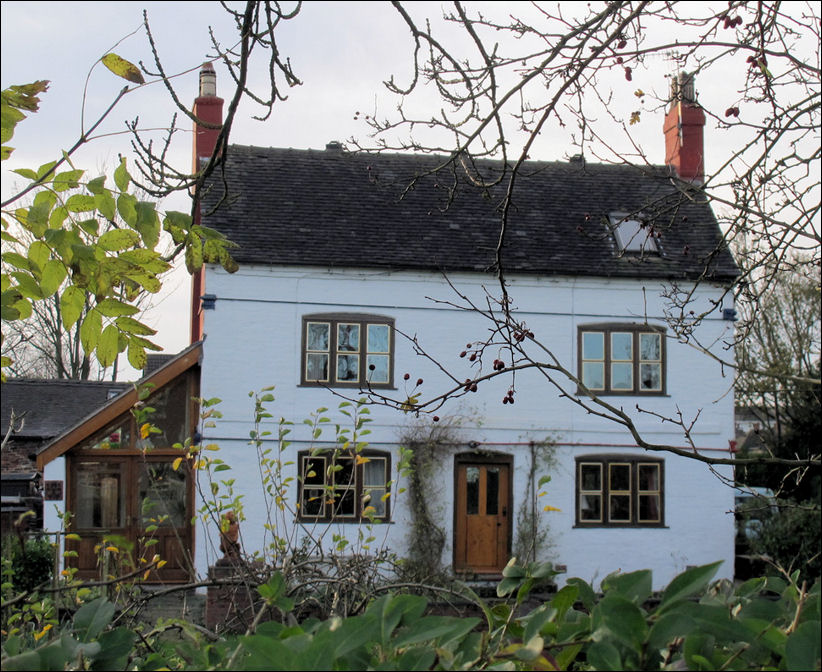
the frontage of Elm House from Handley Street,
Packmoor
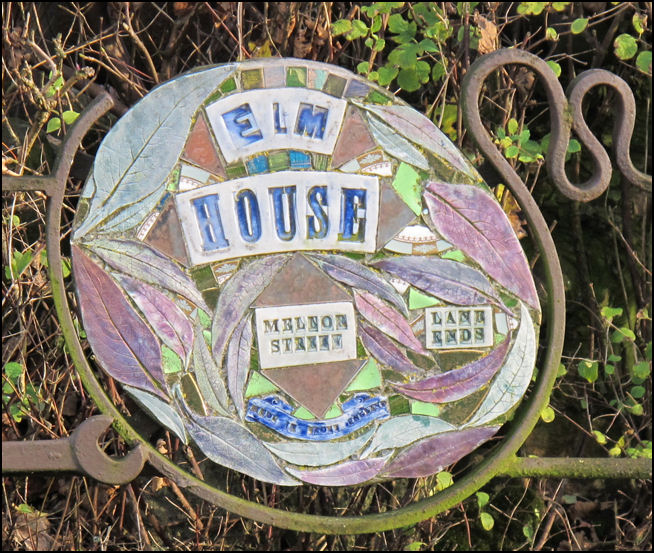
Elm House, Mellor Street, Lane
Ends
Made in Stoke England
photos: November 2011
|
A further notable event happened in
1985: Elm House gained itself a new, remarkable owner, the sculptor, ceramicist, and mosaic artist, Philip Hardaker.
Philip’s work often has political and ecological objectives, communicating comment on historical events. Indeed, the many events of 1985 highlighted above probably proved a great influence on Philip and his work:
His work is also intrinsically linked with being English, and celebrates the creativity within North Staffordshire, and the past production of ceramics in the Potteries. However, although the philosophies, ideas and messages behind his work have serious meaning, and capture the spirit of the age, it is also laced with humour and irony.
Key works of his include:
Entrance to ‘Arthur’s Garden’ in Shelton
In addition, Philip has worked on many community projects and initiatives throughout North Staffordshire, and one of his most impressive contributions is also one of his most recent.
Philip
Hardaker’s bench and the ‘Python of Peace’
View
of the Caldon Canal from ‘Arthur’s Garden’ It is Philip’s philosophy of reuse and renewal that even underpinned his choice of home here in the Potteries: over a hundred years ago, no-one was sure whether the future was the internal combustion engine, electric motors, or steam, but it was plain obvious that horses and donkeys were in trouble; this technological revolution meant that the reason for Elm House’s being was gone. But when Philip Hardaker returned to Stoke-on-Trent, he once again found a use for something that had formerly been considered useless. The late Kirsty MacColl had the following to say about Philip Hardaker back in 1997:
Philip Hardaker is one of North Staffordshire’s greatest talents, up there with Josiah Wedgwood, Suzie Cooper, Arnold Bennett, and other migrants to the Potteries such as Reginald Haggar, Susan Williams-Ellis, and Emma Bridgewater. Hardaker is a renewer, a rescuer, the Womble of the Potteries. A philosopher and prophet, and a proud Yorkshireman, but also a proud, adopted Potter. D.P. 16th November 2011 |
||||||
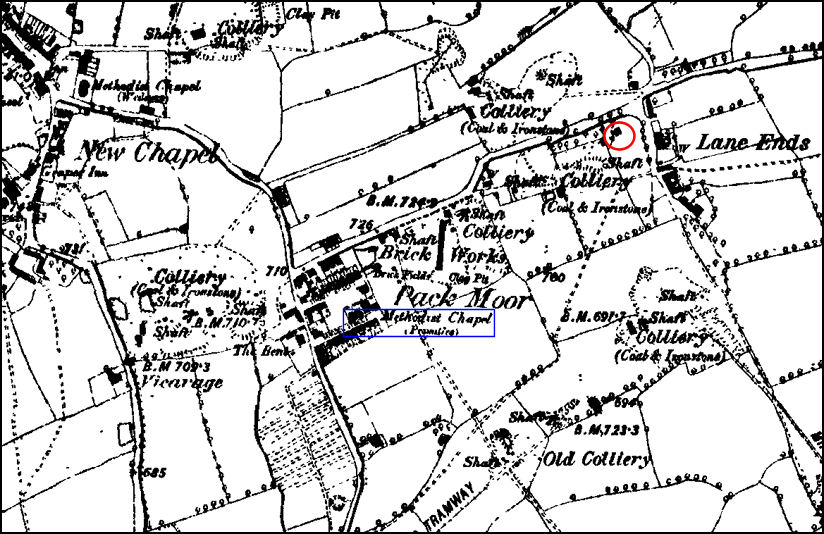
Elm House, Packmoor - marked in
red - 1890 map
the house is surrounded by collieries, clay pits and brick works
the road layout and Packmoor Methodist chuch are still evident today

Elm House, Packmoor - marked in
red - Google Map 2010
the road layout and Packmoor Methodist chuch are evident on both maps
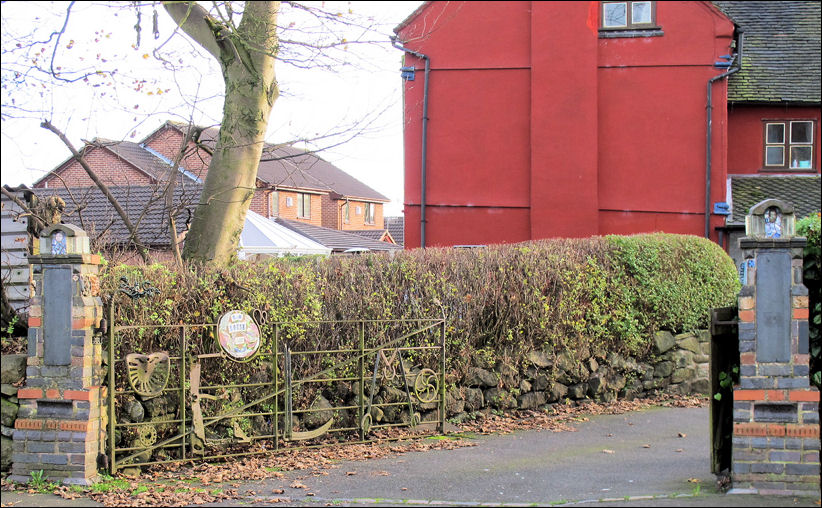
the detail in the gate and gate
posts to Elm House show Philip Hardaker's work
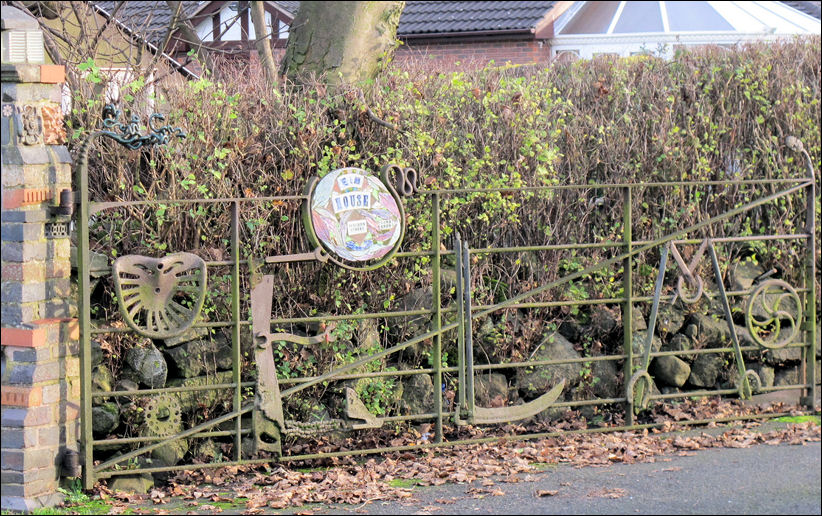
the design of the gate includes
farming impliments
| “It struck me that by using recycled material, a quality coming from its fragmentary nature was imparted to the meaning of the work. I loved the sense of finding a use for something that had formerly been considered useless” - Philip Hardaker |
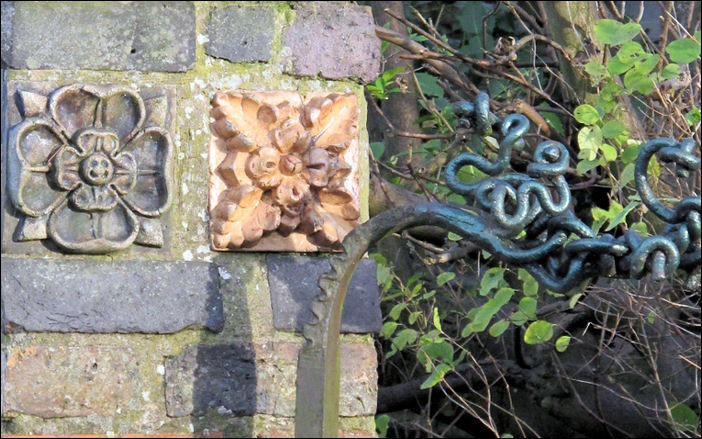
detail of the posts and the
corner of the gate

head on the gate opening
handle

blue printed pottery fragments
surround the faces of comedy and tragedy on the gate posts
![]()
![]()
next: Brindley Ford First
School
contents: index of buildings North of the City - Part 1
[ location map ]
|
Related Pages Listed building details for Elm House, Packmoor Arthur's Garden, Chambelain Street, Shelton St. Peter's community mosaic bench Metal Gateway at Berryhill Greenway external links..
|